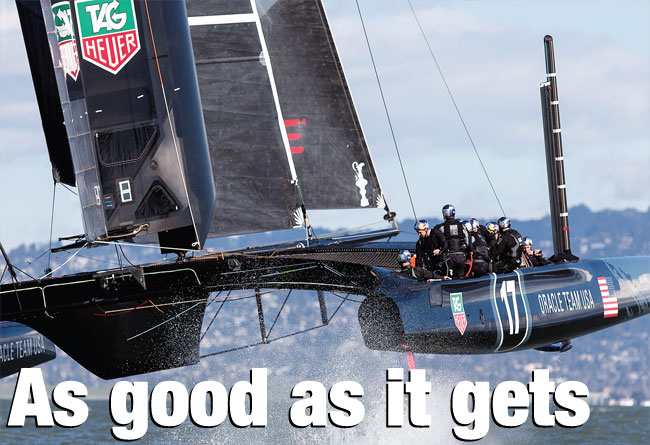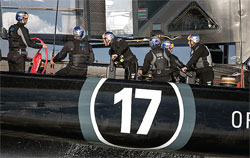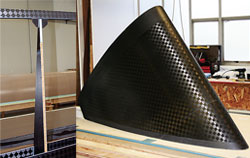

ORACLE TEAM USA turns to
TeXtreme® to reduce weight
The America’s Cup has always been a quest for lightweight solutions, producing better and lighter structures, and the 34th edition of the competition is no exception. What is different from previous campaigns is that this time around the financial climate dictated that finding cost-effective solutions had to play a larger role. To meet these demands Oracle Team USA turned to TeXtreme® Spread Tow carbon reinforcements, with which substantial weight savings were ultimately realised.
TeXtreme® Spread Tow carbon reinforcements are a novel type of composite reinforcements typically used to reduce weight, increase performance and give better surface smoothness in advanced composites. The principle behind the TeXtreme® technology is to weave a fabric using thin Spread Tow unidirectional tapes instead of weaving with yarns as in conventional fabrics. TeXtreme® Spread Tow reinforcement is already used in Formula 1 and in high-end sporting goods including bicycles, golf shafts, ice hockey sticks and advanced aerospace applications, and has now taken the step into AC72s and the America’s Cup.
Chasing lightweight, cost-effective solutions is a major theme of this campaign for Cup Defender Oracle Team USA. Development at the start of the campaign focused on qualifying new materials to save weight and achieve the structural performance required for the new high-performance catamaran class. With time pressures and a requirement for the highest possible performance typical of the Cup, Core Builders Composites evaluated TeXtreme® for both practical manufacturing considerations and mechanical strength and stiffness qualities. After seeing positive results from the initial evaluation both Core Builders Composites and Oracle Team USA discussed and identified the benefits that TeXtreme® could offer to a challenging build.
Dirk Kramers, head of structures at Oracle, says: ‘With the huge time pressure our design department and builders are under during a competition like this, there is only so much time to evaluate new materials. That is why we were so pleased with TeXtreme® as it turned out to offer both the weight savings and performance we were looking for while at the same time being more process efficient. The flexibility in the material range also helped us optimise reinforcement for each specific application.’
One of the paradoxes with carbon reinforcements and prepreg is that the less something weighs the more expensive it becomes. This is especially true for traditional woven cloths and unidirectional pre-pregs with fibre areal weights lower than 200gsm – and once below 100gsm, the price per kilo of fibre increases rapidly.
TeXtreme® is less expensive than traditional 1k carbon woven reinforcements and brings unique benefits of performance increase in terms of weight savings and surface finish, which is critical to the untreated and unpainted surfaces that a weight-driven programme demands. Carbon unidirectionals can go lower in areal weight – commonly available down to 50gsm and in some cases even lower – however, all the laminates used in Oracle Team’s AC72 require reinforcements in at least two directions, consequently an 80gsm TeXtreme® cloth offers a 20% weight saving compared with two layers of 50gsm unidirectional tapes.
There were other advantages of using TeXtreme® cloth over two layers of unidirectional tapes. First there was a reduced labour costs. It was possible to put down half the number of plies as opposed to the two layers of unidirectional tape. Depending on the application TeXtreme® was used both at +45/-45 and 0/90. Normally when placing unidirectional fibres on the bias this is very tedious as the unidirectionals need to be cut and placed manually at the exact angles desired. The Spread Tow tapes in TeXtreme® fabrics are always perfectly aligned, so putting down +45/-45 became very efficient.

Top/above: the clever indent curvature on Oracle’s AC72 topsides saves weight and windage and adds considerable panel stability.
Below: this tailpiece and exposed wing nose element illustrate the multi-directional fibres in the TeXtreme® Spread Tow product

Another time-saving aspect is the handling properties of TeXtreme®, especially for the dry cloth. Conventional dry materials have nothing but a selvedge to hold them together, which means that as soon as you start cutting them they need to be handled very gently if they are not to fall apart. With TeXtreme® cloths this was not a problem thanks to the binder that keeps the fabric together. An additional advantage was the increased toughness due to the interleaved Spread Tows of unidirectional fibres.
Core Builders Composites purchased several TeXtreme® variants that were subsequently used on different applications and for different purposes. The materials were purchased as both dry fabric and pre-preg. TeXtreme® 160gsm cloth is used on exposed surfaces where the increased skin thickness/toughness offsets the weight penalty; TeXtreme® 100gsm cloth was widely used in the construction of wing elements and fairings; and TeXtreme® 80gsm cloth was used in the lightest weight fairings, typically on a foam sandwich rather than honeycomb.
Tim Smyth, head of Core Builders Composites, says: ‘TeXtreme® products provided us with a wide range of aerial weights and fibre styles to choose from – all at competitive prices compared to other options. We are very happy with the surface finish and laminate quality of the parts we have made using TeXtreme®.
‘TeXtreme® has also given us options in processing laminates in a way that reduces lay-up time at the same time as improving quality. In addition, using these materials has delivered weight savings that would have been impossible with any other composite reinforcement we are aware of, considering our demanding performance requirements.’
The most visible usage of TeXtreme® on Oracle USA’s AC72s is in the flap noses and aft portions of the main wing element hard shell. The flap noses work primarily in torsion and are stiffness and strength critical. The angle of the flap laminate is optimised to provide the correct torsional stiffness profile along the length of the aerodynamic foil. Because these flaps are quite exposed, especially taking account of the high apparent wind speed in which they typically operate, durability of the honeycomb structure versus reduced weight also had to be considered.
In contrast, the less exposed aft portion of the main element hard shell was designed to be as light as possible. Here the thin sandwich laminate of TeXtreme® and lightweight foam core form the extended hard shell of the wing main element to deliver optimal aerodynamic performance; the only structural requirement was to be sufficiently rigid to maintain the required aero shape.
For the construction of the flap noses either dry fabrics or prepreg could be used, but to meet the tight schedule the pre-preg laminate was preferred for the larger elements. Of the chosen TeXtreme ® variants, the 80gsm dry cloth was the lightest solution.
For some applications Core Builders Composites combined dry cloths with pre-preg glue film or resin film, as there was a significant cost premium for the pre-preg option. So the pre-preg was reserved for the larger panels where the labour savings offset the additional material cost.
To manufacture the flaps as lightly as possible, normal pre-preg sandwich construction methods were critically assessed to determine where weight and cost could be saved. Typical prepreg sandwich panel construction could be either multiple cure (one each for outside skin, core bond and then inside skin) or a single co-cure of the skins and core adhesive. A single co-cure of the skins and core adhesive is more efficient but with such light areal weights invariably leads to dimpling of the skin into the core – and given the aerodynamic requirements of the part this solution was unacceptable. Therefore the decision was made to go with multiple cures, constructing the skins separately and then bonding them to the core without full vacuum to prevent dimpling. Another benefit of this approach is that it allowed for the inside of the skin to be sealed against moisture ingress.
Again, to reduce weight different methods of bonding the Nomex honeycomb core were assessed, and it was determined that if the adhesive was placed only on the core face as opposed to all over the surface of the skin this would give a lighter solution than normal pre-preg construction. The key to achieving a lighter ambient solution is that the adhesive was only exactly where it was required: the surface of the honeycomb cells. Weight savings from using TeXtreme® would be in the order of 100gsm – which over approximately 50m2 of flap nose area equals 5kg, which is a significant weight saving at this level.
The tooling for the flap noses would typically be manufactured as a female mould. The difficulty is then achieving a goodquality skin-core bond without the risk of bridging the core at the apex. On a male tool this could be avoided by being able to pull the core down onto the shape.
The difficulty with male tools is that the level of finish and tolerance may not be as good. A unique compromise was found that was achievable by exploiting the toughness and flexibility of TeXtreme® fabrics. Specifically the skins were pre-cured and then draped onto a male former – the skins having the finish of the flat table. Then, using an over-expanded honeycomb, it was possible to pre-bond the core to the outside skin, then drape the half-sandwich over the inside skin that was already draped on the former. This construction method allowed the former to be manufactured for ambient temperature and vacuum rather than for an elevated pre-preg cure, a huge saving for the team made possible through the characteristics of TeXtreme®.
‘To summarise, TeXtreme® made it possible for us to achieve weight savings in the wing flap application alone to a total of 5kg,’ says Tim Smyth, ‘while the saving across the whole AC72 ended up as a substantial number; and without comprising on performance and safety in the design of the composite parts.
‘That, in combination with the possibility of improving the performance and surface finish of the laminates, together with the reduced spend in labour, made for a very attractive solution. We will definitely keep it in mind for our future projects.’
Click here for more information on the TeXtreme® range »
We invite you to read on and find out for yourself why Seahorse is the most highly-rated source in the world for anyone who is serious about their racing.
To read on simply SIGN up NOW
Take advantage of our very best subscription offer or order a single copy of this issue of Seahorse.
Online at:
www.seahorse.co.uk/shop and use the code TECH20
Or for iPad simply download the Seahorse App at the iTunes store


